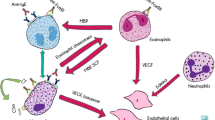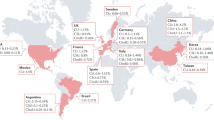Abstract
Chronic urticaria is a common skin disease without an etiology in the majority of cases. The similarity of symptoms and pathology to allergen-induced skin reactions supports the idea that skin mast cell and blood basophil IgE receptor activation is involved; however, no exogenous allergen trigger has been identified. Recent evidence supports a role for blood basophils in disease expression. Specifically, blood basopenia is noted in active disease with the recruitment of blood basophils to skin lesional sites. In addition, blood basophils display altered IgE receptor-mediated degranulation that reverts in disease remission. In active chronic idiopathic urticaria (CIU) subjects, changes in IgE receptor-signaling molecule expression levels accompany the altered degranulation function in blood basophils. The arrival of therapies targeting IgE has further shown that altered blood basophil degranulation behavior has potential use as a disease biomarker in CIU.
Similar content being viewed by others
References and Recommended Reading
Greaves M: Chronic urticaria. J Allergy Clin Immunol 2000, 105:664–672.
Kaplan AP: Chronic urticaria: pathogenesis and treatment. J Allergy Clin Immunol 2004, 114:465–474.
Toubi E, Kessel A, Avshovich N, et al.: Clinical and laboratory parameters in predicting chronic urticaria duration: a prospective study of 139 patients. Allergy 2004, 59:869–873.
Grob JJ, Revuz J, Ortonne JP, et al.: Comparative study of the impact of chronic urticaria, psoriasis and atopic dermatitis on the quality of life. Br J Dermatol 2005, 152:289–295.
O’Donnell BF, Lawlor F, Simpson J, et al.: The impact of chronic urticaria on the quality of life. Br J Dermatol 1997, 136:197–201.
Delong LK, Culler SD, Saini SS, et al.: Annual direct and indirect costs of chronic idiopathic urticaria: a cost analysis of fifty non-immunocompromised patients. Arch Dermatol 2008, 144:35–39.
Smith CH, Kepley C, Schwartz LB, Lee TH: Mast cell number and phenotype in chronic idiopathic urticaria. J Allergy Clin Immunol 1995, 96:360–364.
Jacques P, Lavoie A, Bedard PM, et al.: Chronic idiopathic urticaria: profiles of skin mast cell histamine release during active disease and remission. J Allergy Clin Immunol 1992, 89:1139–1143.
Cohen RW, Rosenstreich DL: Discrimination between urticaria-prone and other allergic patients by intradermal skin testing with codeine. J Allergy Clin Immunol 1986, 77:802–807.
Ying S, Kikuchi Y, Meng Q, et al.: TH1/TH2 cytokines and inflammatory cells in skin biopsy specimens from patients with chronic idiopathic urticaria: comparison with the allergen-induced late-phase cutaneous reaction. J Allergy Clin Immunol 2002, 109:694–700.
Sabroe RA, Poon E, Orchard GE, et al.: Cutaneous inflammatory cell infiltrate in chronic idiopathic urticaria: comparison of patients with and without anti-FcepsilonRI or anti-IgE autoantibodies. J Allergy Clin Immunol 1999, 103:484–493.
Caproni M, Volpi W, Macchia D, et al.: Infiltrating cells and related cytokines in lesional skin of patients with chronic idiopathic urticaria and positive autologous serum skin test. Exp Dermatol 2003, 12:621–628.
Gruber BL, Baeza ML, Marchese MJ, et al.: Prevalence and functional role of anti-IgE autoantibodies in urticarial syndromes. J Invest Dermatol 1988, 90:213–217.
Hide M, Francis DM, Grattan CE, et al.: Autoantibodies against the high-affinity IgE receptor as a cause of histamine release in chronic urticaria. N Engl J Med 1993, 328:1599–1604.
Brodell LA, Beck LA, Saini SS: Pathophysiology of chronic urticaria. Ann Allergy Asthma Immunol 2008, 100:291–297.
Sheikh J: Autoantibodies to the high-affinity IgE receptor in chronic urticaria: how important are they? Curr Opin Allergy Clin Immunol 2005, 5:403–407.
Karasuyama H, Mukai K, Tsujimura Y, Obata K: Newly discovered roles for basophils: a neglected minority gains new respect. Nat Rev Immunol 2009, 9:9–13.
Mukai K, Obata K, Tsujimura Y, Karasuyama H: New insights into the roles for basophils in acute and chronic allergy. Allergol Int 2009, 58:11–19.
Obata K, Mukai K, Tsujimura Y, et al.: Basophils are essential initiators of a novel type of chronic allergic inflammation. Blood 2007, 110:913–920.
Grattan CE, Dawn G, Gibbs S, Francis DM: Blood basophil numbers in chronic ordinary urticaria and healthy controls: diurnal variation, influence of loratadine and prednisolone and relationship to disease activity. Clin Exp Allergy 2003, 33:337–341.
Caproni M, Giomi B, Volpi W, et al.: Chronic idiopathic urticaria: infiltrating cells and related cytokines in autologous serum-induced wheals. Clin Immunol 2005, 114:284–292.
Schleimer RP, Lichtenstein LM, Gillespie E: Inhibition of basophil histamine release by anti-inflammatory steroids. Nature 1981, 292:454–455.
Charlesworth EN, Kagey-Sobotka A, Schleimer RP, et al.: Prednisone inhibits the appearance of inflammatory mediators and the influx of eosinophils and basophils associated with the cutaneous late-phase response to allergen. J Immunol 1991, 146:671–676.
Grattan CE, Walpole D, Francis DM, et al.: Flow cytometric analysis of basophil numbers in chronic urticaria: basopenia is related to serum histamine releasing activity. Clin Exp Allergy 1997, 27:1417–1424.
Greaves MW, Plummer VM, McLaughlan P, Stanworth DR: Serum and cell bound IgE in chronic urticaria. Clin Allergy 1974, 4:265–271.
Kern F, Lichtenstein LM: Defective histamine release in chronic urticaria. J Clin Invest 1976, 57:1369–1377.
Sabroe RA, Francis DM, Barr RM, et al.: Anti-Fc(episilon)RI auto antibodies and basophil histamine releasability in chronic idiopathic urticaria. J Allergy Clin Immunol 1998, 102:651–658.
Luquin E, Kaplan AP, Ferrer M: Increased responsiveness of basophils of patients with chronic urticaria to sera but hypo-responsiveness to other stimuli. Clin Exp Allergy 2005, 35:456–460.
Vonakis BM, Vasagar K, Gibbons J, et al.: Basophil FceRI histamine release parallels expression of Src-homology2-containing inositol phosphatases in chronic idiopathic urticaria. J Allergy Clin Immunol 2007, 119:441–448.
Vasagar K, Vonakis BM, Gober L, et al.: Evidence of in vivo basophil activation in chronic idiopathic urticaria. Clin Exp Allergy 2006, 36:770–776.
Lourenco FD, Azor MH, Santos JC, et al.: Activated status of basophils in chronic urticaria leads to interleukin-3 hyper-responsiveness and enhancement of histamine release induced by anti-IgE stimulus. Br J Dermatol 2008, 158:979–986.
Kepley CL, Youssef L, Andrews RP, et al.: Syk deficiency in nonreleaser basophils. J Allergy Clin Immunol 1999, 104:279–284.
Macglashan D, Miura K: Loss of syk kinase during IgE-mediated stimulation of human basophils. J Allergy Clin Immunol 2004, 114:1317–1324.
Macglashan DW Jr: Relationship between spleen tyrosine kinase and phosphatidylinositol 5′ phosphatase expression and secretion from human basophils in the general population. J Allergy Clin Immunol 2007, 119:626–633.
Harris SJ, Parry RV, Westwick J, Ward SG: Phosphoinositide lipid phosphatases: natural regulators of phosphoinositide 3-kinase signaling in T lymphocytes. J Biol Chem 2008, 283:2465–2469.
Kimura T, Sakamoto H, Appella E, Siraganian RP: The negative signaling molecule SH2 domain-containing inositol-polyphosphate 5-phosphatase (SHIP) binds to the tyrosine-phosphorylated beta subunit of the high affinity IgE receptor. J Biol Chem 1997, 272:13991–13996.
Gimborn K, Lessmann E, Kuppig S, et al.: SHIP down-regulates FcepsilonR1-induced degranulation at supraoptimal IgE or antigen levels. J Immunol 2005, 174:507–516.
Huber M, Helgason CD, Damen JE, et al.: The src homology 2-containing inositol phosphatase (SHIP) is the gatekeeper of mast cell degranulation. Proc Natl Acad Sci U S A 1998, 95:11330–11335.
Vonakis BM, Gibbons S Jr, Sora R, et al.: Src homology 2 domain-containing inositol 5′ phosphatase is negatively associated with histamine release to human recombinant histamine-releasing factor in human basophils. J Allergy Clin Immunol 2001, 108:822–831.
Gibbs BF, Rathling A, Zillikens D, et al.: Initial Fc epsilon RI-mediated signal strength plays a key role in regulating basophil signaling and deactivation. J Allergy Clin Immunol 2006, 118:1060–1067.
Leung WH, Bolland S: The inositol 5′-phosphatase SHIP-2 negatively regulates IgE-induced mast cell degranulation and cytokine production. J Immunol 2007, 179:95–102.
Vonakis BM, Saini SS: Syk-deficientbasophils from donors with chronic idiopathic urticaria exhibit a spectrum of releasability. J Allergy Clin Immunol 2008, 121:262–264.
Eckman J, Hamilton RG, Gober LM, et al.: Basophil phenotypes in chronic idiopathic urticaria in relation to disease activity and autoantibodies. J Invest Dermatol 2008, 128:1956–1963.
Baker R, Vasagar K, Ohameje N, et al.: Basophil histamine release activity and disease severity in chronic idiopathic urticaria. Ann Allergy Asthma Immunol 2008, 100:244–249.
Morgan M, Khan DA: Therapeutic alternatives for chronic urticaria: an evidence-based review, part 1. Ann Allergy Asthma Immunol 2008, 100:403–412.
Gober L, Sterba P, Eckman J, Saini S: Effect of anti-IgE (omalizumab) in chronic idiopathic urticaria patients. J Allergy Clin Immunol 2008, 121:S147.
Author information
Authors and Affiliations
Corresponding author
Rights and permissions
About this article
Cite this article
Saini, S.S. Basophil responsiveness in chronic urticaria. Curr Allergy Asthma Rep 9, 286–290 (2009). https://doi.org/10.1007/s11882-009-0040-3
Published:
Issue Date:
DOI: https://doi.org/10.1007/s11882-009-0040-3




